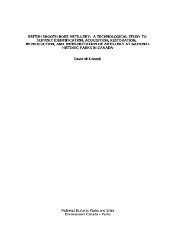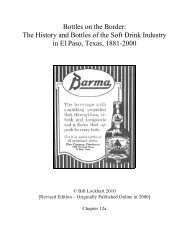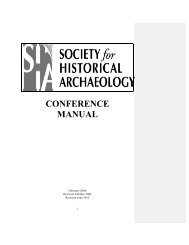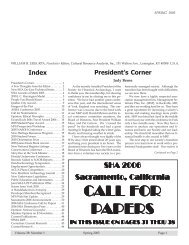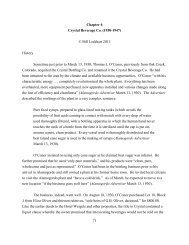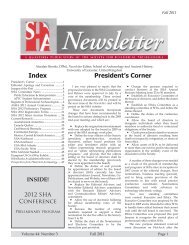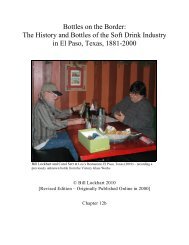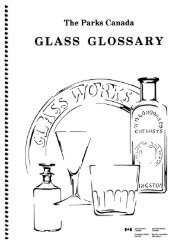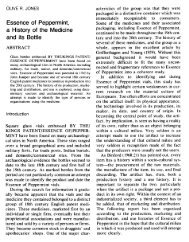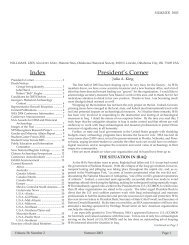Bottles on the Border: The History and Bottles of the Soft Drink ...
Bottles on the Border: The History and Bottles of the Soft Drink ...
Bottles on the Border: The History and Bottles of the Soft Drink ...
You also want an ePaper? Increase the reach of your titles
YUMPU automatically turns print PDFs into web optimized ePapers that Google loves.
This leaves a period <strong>of</strong> at least 15 years unaccounted for. Since all examples I have found<br />
<strong>of</strong> <strong>the</strong> early bottles were made by <strong>the</strong> Illinois Glass Co., <strong>on</strong>e <strong>of</strong> <strong>the</strong> most successful glass plants <strong>of</strong><br />
<strong>the</strong> period, it is highly unlikely that <strong>the</strong> firm would have clung for l<strong>on</strong>g to an outmoded<br />
technique. <strong>The</strong>refore, <strong>on</strong>e <strong>of</strong> two explanati<strong>on</strong>s is likely. <strong>The</strong>re may be ano<strong>the</strong>r style <strong>of</strong> bottles,<br />
perhaps even <strong>the</strong> same style with tooled finishes, that we have not yet discovered. Since <strong>the</strong><br />
plant certainly used each bottle until it wore out (<strong>the</strong>se were returnable bottles), this is within <strong>the</strong><br />
realm <strong>of</strong> possibility. It seems more likely, however, that <strong>the</strong> firm adopted generic Hutchins<strong>on</strong><br />
bottles during <strong>the</strong> period – <strong>on</strong>es identified <strong>on</strong>ly by paper labels.<br />
Staski (1984b:59, 192-193, 204) found several Houck & Dieter bases in a feature with an<br />
identified c<strong>on</strong>text <strong>of</strong> late 1880s-early 1890s. Staski’s drawing (p. 59) fits <strong>the</strong> early style,<br />
although he failed to identify <strong>the</strong> finish technique. Staski’s bottles are almost certainly <strong>the</strong> first<br />
style, <strong>and</strong> <strong>the</strong> c<strong>on</strong>text supports an 1881-ca. 1885 date range for <strong>the</strong> bottles.<br />
Table 5-1 - Bottle Chr<strong>on</strong>ology for Houck & Dieter 4<br />
Style Changes<br />
Dates<br />
Hutchins<strong>on</strong>; tall, applied finish; no plate 1881-ca. 1885<br />
Unknown; probably Hutchins<strong>on</strong>; paper label ca. 1885-ca. 1900<br />
Hutchins<strong>on</strong>; “funnel,” tooled finish; round plate <strong>on</strong> fr<strong>on</strong>t ca. 1900-ca. 1905*<br />
Embossed; 2-pc mold, crown finish; “tombst<strong>on</strong>e”-shaped label ca. 1898-ca. 1905*<br />
Crown finish; 6-panel; embossed ca. 1903-1912<br />
* See text for discussi<strong>on</strong> <strong>of</strong> overlaps.<br />
Method <strong>of</strong> Manufacture: Blown into mold<br />
Color: Light Blue, Aqua<br />
Size (in cm.): 18.2 (h); 7.2 (d) [16.8-16.9 (h); 6.3 (d)]<br />
Primary Labeling Style: Embossed<br />
Finish: Hutchins<strong>on</strong> - <strong>The</strong> Houck & Dieter bottles used a spring stopper, probably <strong>the</strong> style<br />
manufactured by W. H. Hutchins<strong>on</strong> & S<strong>on</strong>, patented April 8, 1879. <strong>The</strong> Hutchins<strong>on</strong>'s Patent<br />
Spring Stopper was in general use from 1880 to about 1905 or later when it was replaced by <strong>the</strong><br />
crown cap. Some varieties , however, c<strong>on</strong>tinued to be made as late as 1918 (Paul & Parmalee<br />
4<br />
Note that all this informati<strong>on</strong> reflects a major update <strong>on</strong> Lockhart (2000) <strong>and</strong> Lockhart<br />
(2003:3-6)<br />
87



